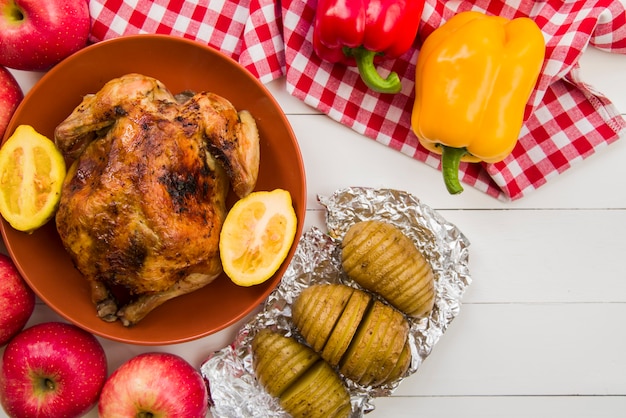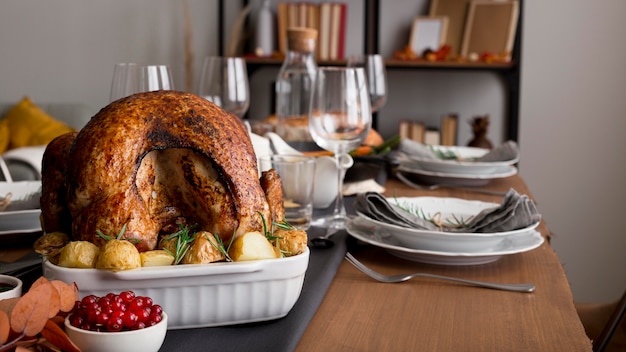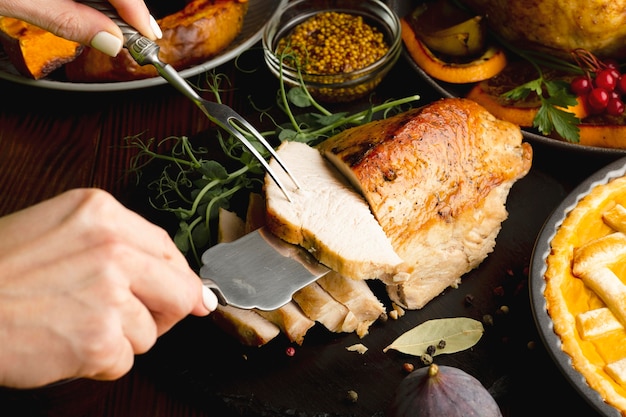The aroma of a perfectly roasted turkey fills the air, the centerpiece of a festive gathering, a symbol of tradition and celebration. It’s a dish that brings families and friends together, sharing laughter, stories, and, of course, delicious food. But tackling a 20-pound turkey can feel like a daunting task, especially when it comes to figuring out the perfect cooking time.
Over the years, I’ve perfected my turkey-roasting skills, and I’m here to share all the secrets I’ve learned. From choosing the right bird to ensuring it’s cooked to perfection, we’ll navigate the ins and outs of roasting a 20-pound turkey together. We’ll delve into the science of cooking times, explore different techniques, and tackle common questions that arise. Get ready to become a turkey-roasting maestro, impressing your guests with a show-stopping centerpiece that's juicy, flavorful, and perfectly cooked.
(Part 1) The Turkey Chronicles: A Journey from Farm to Table

It all starts with selecting the right turkey. I’m a big fan of fresh, free-range birds whenever possible. The flavor is unparalleled, and knowing the origins of your food adds a special touch to the experience. But if you’re working with a tight schedule, frozen turkeys are a great alternative, offering convenience without sacrificing quality.
The Size Factor: Choosing the Right Bird
A 20-pound turkey, with its impressive size, is a perfect choice for a large gathering, serving around 10-12 people generously. Check the packaging for any thawing instructions if you’re working with a frozen bird, ensuring it’s properly thawed before you begin cooking.
The Prep Game: Setting the Stage for a Successful Roast
Once your turkey is ready, it’s time for the initial prep work, a crucial step that sets the foundation for a delicious outcome. Rinse the bird inside and out with cold water, then pat it dry thoroughly with paper towels. Next, we move on to a little trick I learned from my grandmother: stuff the cavity with a mix of chopped onions, carrots, and celery. This simple addition adds a depth of flavor to the bird and helps keep it moist during roasting. It’s a classic technique that adds a touch of charm and nostalgia to the process.
The Brining Debate: A Dive into the Science of Moisture
Now, let's dive into the age-old question: to brine or not to brine? Brining involves soaking the turkey in a salt-water solution, a process that transforms the bird’s texture and flavor. It works by drawing out excess moisture and then replacing it with a salt-rich solution, ultimately leading to a juicier, more flavorful turkey.
I’m a firm believer in the power of brining, especially with a larger turkey like this one. The results are undeniable, resulting in a tender, succulent bird that will impress even the most discerning palate. Just make sure you have enough space in your refrigerator to accommodate the brining container, as a 20-pound turkey will need a generous amount of room.
The Stuffing Dilemma: A Safe and Delicious Solution
Stuffing is a beloved element of traditional turkey dinners, adding a comforting, savory dimension to the meal. However, stuffing the turkey itself presents a food safety concern. It’s difficult to ensure the stuffing reaches a safe internal temperature of 165°F while the turkey is roasting, potentially leading to undercooked stuffing.
Instead, I recommend making your stuffing separately and baking it in a casserole dish. This allows you to cook the stuffing to perfection, eliminating the food safety risk while still enjoying its comforting flavors.
(Part 2) The Oven's Embrace: Roasting for a Perfect Outcome

With your prepped turkey ready to go, it’s time to move on to the roasting process. The oven becomes your culinary canvas, transforming the humble bird into a delectable centerpiece.
The Temperature Tango: Finding the Right Heat Balance
The ideal temperature for roasting a 20-pound turkey is 325°F. This temperature range allows for even cooking, ensuring the turkey is cooked through without drying out. Resist the temptation to crank up the heat, even if you’re eager for the process to move faster. High heat can lead to uneven cooking and a dry, disappointing result. Patience is key here, allowing the turkey to cook slowly and evenly.
Timing is Everything: Understanding the Cooking Time
Now, let’s address the big question: how long will it take to roast a 20-pound turkey? The general rule of thumb is to allow 15 minutes per pound of unstuffed turkey at 325°F. So, for a 20-pound turkey, you’d be looking at roughly 300 minutes, or 5 hours.
However, this is just a guideline. Ovens can vary in their heating efficiency, and the actual cooking time may differ. Always monitor your turkey closely throughout the roasting process, checking the internal temperature regularly to ensure it’s cooked to perfection.
The Art of Basting: Keeping the Turkey Moist and Flavorful
Basting is a vital step in ensuring the turkey stays moist and develops a beautiful, golden-brown crust. It involves periodically pouring a mixture of melted butter, chicken broth, and herbs over the turkey during the roasting process.
Start basting about halfway through the cooking time, and continue basting every 30 minutes or so. This technique keeps the skin moist and prevents it from drying out, while also adding a delicious layer of flavor to the bird.
(Part 3) The Culinary Verdict: Determining Doneness

The moment of truth has arrived: how do you know when your turkey is cooked through? It’s crucial to ensure the turkey is cooked to a safe internal temperature to prevent any foodborne illness.
The meat thermometer: Your Culinary Compass
A meat thermometer is an essential tool in any cook's arsenal, especially when dealing with a large turkey. Insert the thermometer into the thickest part of the thigh, ensuring it doesn’t touch any bone. The turkey is ready when the internal temperature reaches 165°F.
The Visual Clues: A Guide for Checking Doneness
You can also check for doneness visually by observing the turkey's juices. If they run clear when you pierce the thigh, it's a sign that the turkey is cooked through. If they're still pink, it needs a little more time in the oven.
The Resting Ritual: Letting the Turkey Relax
Once your turkey has reached the desired temperature, don’t rush to carve it. Allow it to rest for at least 15 minutes before carving. This resting period allows the juices to redistribute throughout the meat, resulting in a juicier, more flavorful turkey.
(Part 4) Beyond the Basics: Expert Tips for a Show-Stopping Roast
Now that you’ve grasped the fundamentals of roasting a turkey, let’s explore some advanced tips and techniques that can elevate your roasting game to the next level.
The Dark Meat Advantage: Prioritizing Breast Tenderness
Dark meat tends to cook faster than white meat. To ensure the breast doesn’t overcook while the dark meat finishes, I always place the turkey breast side up in the oven. This allows the breast to cook more gently, preventing it from drying out. Plus, it makes the basting process a bit easier, as the breast is readily accessible.
The Foil Technique: Trapping Moisture for a Juicy Bird
If you want to maximize the turkey’s juiciness, try wrapping it in foil for the first hour or so of cooking. This creates a steamy environment that traps moisture, preventing the skin from drying out. Just remove the foil for the last hour or so of cooking to allow the skin to crisp up and develop a beautiful golden-brown color.
A Touch of Lemon: Adding a Citrusy Twist
A simple slice of lemon can add a bright, citrusy flavor to your turkey. Before roasting, rub the skin with a slice of lemon to infuse the meat with a subtle, refreshing aroma.
The Herb Factor: Elevating Flavor with Aromatic Additions
Herbs are a cook's secret weapon, adding layers of complexity and depth to any dish. Before roasting, rub the turkey with a blend of herbs like rosemary, thyme, sage, or oregano. You can also add a few sprigs of herbs to the cavity of the turkey, further enhancing its flavor.
(Part 5) From Oven to Table: Carving Your Culinary Masterpiece
With your turkey perfectly roasted and resting, it’s time for the grand finale: carving. It's a moment of anticipation, as the aroma of the roasted bird fills the air, signaling the start of a delicious feast.
The Carving Technique: Slicing with Precision and Confidence
I prefer to use a sharp carving knife for this task, ensuring clean, precise cuts. Start by slicing the legs off at the joint, then separate the thighs from the drumsticks. Carefully carve the breast meat, slicing across the grain to create tender, manageable pieces.
Arranging the Feast: A Culinary Showcase for Your Guests
Now that your turkey is beautifully carved, it’s time to arrange it on a platter, ready for presentation. Add a touch of flair by incorporating side dishes such as roasted vegetables, mashed potatoes, or cranberry sauce. This creates a visually appealing and delicious spread that will impress your guests.
(Part 6) The Leftovers Legacy: Transforming Turkey into Delicious Meals
Who doesn’t love turkey leftovers? The deliciousness doesn’t end with the initial meal. With a little creativity, you can transform leftover turkey into a variety of tasty dishes, making the most of your culinary masterpiece.
turkey sandwiches: A Classic comfort food
Start with the classic: turkey sandwiches. Pile leftover turkey onto crusty bread, add a layer of lettuce, tomato, and a creamy mayonnaise spread for a satisfying lunch or dinner.
turkey soup: A Warm and Hearty Meal
Transform your leftover turkey into a comforting turkey soup. Combine it with chopped vegetables such as carrots, celery, and potatoes, simmer it in a flavorful broth, and season it to perfection.
turkey salad: A Light and Refreshing Option
For a lighter and more refreshing option, create a delicious turkey salad. Combine leftover turkey with mayonnaise, chopped celery, onion, and your favorite herbs. Serve it on a bed of lettuce, between slices of bread, or on crackers for a tasty lunch or snack.
turkey pot pie: A Baked Delight
For a fancier and more substantial dish, make a turkey pot pie. Combine your leftover turkey with a rich gravy, a medley of vegetables, and top it with a flaky crust. Bake it until the crust is golden brown and the filling is bubbling, creating a warm and comforting meal.
Turkey Shepherd's Pie: A Cozy Comfort Food
For a cozy and comforting meal, try a turkey shepherd's pie. Layer leftover turkey with a creamy mashed potato topping, then bake it until the potatoes are golden brown and bubbly. It’s a heartwarming dish that's perfect for a chilly evening.
(Part 7) Turkey Tales: My Personal Experiences in the Kitchen
I’ve been cooking turkeys for years, and along the way, I’ve had my fair share of triumphs and, let’s be honest, a few mishaps. But even the mistakes have taught me valuable lessons, shaping my approach to roasting the perfect turkey.
The Year of the Dry Turkey: A Lesson Learned the Hard Way
One year, I decided to skip brining, thinking it was an unnecessary step. The result? A dry, disappointing turkey. It was a lesson learned the hard way, proving the undeniable benefits of brining, especially with a larger bird. From that day forward, I’ve always made sure to brine my turkey, ensuring it’s juicy and flavorful.
The Overcooked Breast: A Cautionary Tale
Another time, I got carried away with the roasting time, forgetting the importance of checking the internal temperature. My breast ended up overcooked, a reminder that using a meat thermometer is essential for a perfectly cooked turkey.
The Carving Chaos: A Moment of Humour and a Lesson in Sharp Knives
And then there was the time I attempted to carve the turkey with a dull knife. It was a disaster! The turkey ended up looking like it had been in a wrestling match. It was a humorous experience, but it also reinforced the importance of using sharp knives for carving, ensuring clean cuts and a beautifully presented turkey.
(Part 8) Turkey FAQs: Answers to Your Burning Questions
Now that we've covered all the key aspects of roasting a 20-pound turkey, let's address some frequently asked questions.
What if my turkey isn’t fully cooked?
If your turkey isn’t fully cooked, don’t panic! Simply return it to the oven and continue cooking until it reaches the safe internal temperature of 165°F. Keep an eye on it and check the temperature every 15 minutes or so to ensure it's cooked through.
Can I stuff my turkey with a bread-based stuffing?
While you can stuff your turkey with bread-based stuffing, it's always best to cook the stuffing separately. This ensures that the stuffing reaches a safe internal temperature of 165°F, eliminating the risk of undercooked stuffing.
How can I prevent my turkey from drying out?
To prevent your turkey from drying out, employ these techniques: brine it, baste it regularly, and wrap it in foil for the first hour or so of cooking. These strategies help to trap moisture and prevent the skin from drying out, resulting in a succulent and flavorful bird.
What should I do if my turkey is overcooked?
Unfortunately, there’s not much you can do to fix an overcooked turkey. However, you can try to salvage the breast meat by slicing it thinly and using it in dishes like sandwiches or salads.
What is the best way to reheat leftover turkey?
The best way to reheat leftover turkey is in the oven or microwave. Preheat your oven to 325°F and bake the turkey until it’s heated through. Or, microwave the turkey in 30-second intervals, stirring in between, until it’s heated through.
I hope this comprehensive guide has equipped you with the knowledge and confidence to roast a 20-pound turkey like a pro. Remember, practice makes perfect, so don’t be afraid to experiment and explore different techniques. And most importantly, have fun with it! After all, what’s a holiday feast without a beautiful, perfectly roasted turkey to bring everyone together?
Everyone is watching

How to Cook Frozen Lobster Tails Perfectly: A Step-by-Step Guide
RecipesLobster. Just the word conjures up images of lavish meals, special occasions, and a taste of luxury. But let's...

Pork Fillet Cooking Time: How Long to Cook It Perfectly
RecipesPork fillet, or tenderloin as it's sometimes called, is a real favourite in our house. It's so versatile, and...

Pigs in a Blanket Cooking Time: How Long to Bake for Perfect Results
RecipesAh, pigs in a blanket. Just the name conjures up images of those delightful little parcels of crispy pastry en...

The Ultimate Guide to Cooking Delicious Frankfurters
RecipesLet's face it, we all love a good frankfurter. It's a classic, simple, and always satisfying. But let's be rea...

Wolf Meat Recipes: A Guide to Cooking Wild Game
RecipesLet's be honest, you don't see wolf meat at your local butcher shop every day. It's a bit of a wild card, but ...
